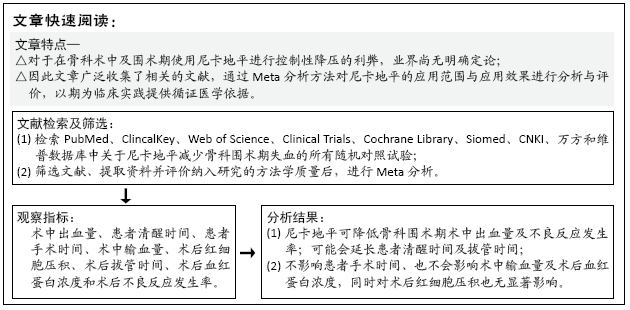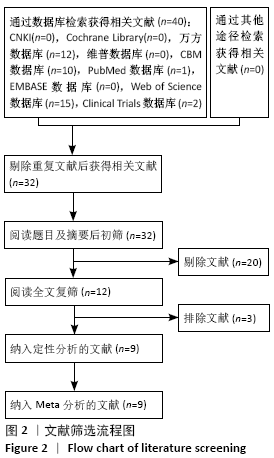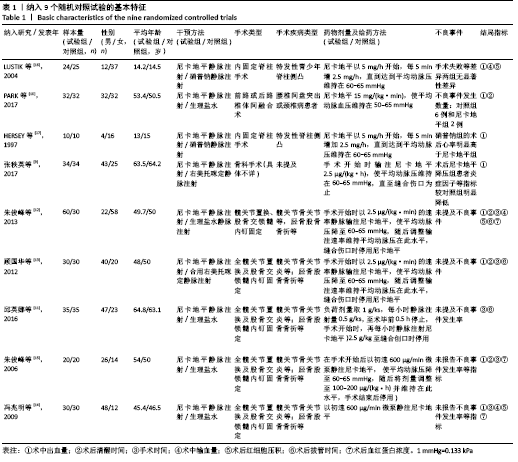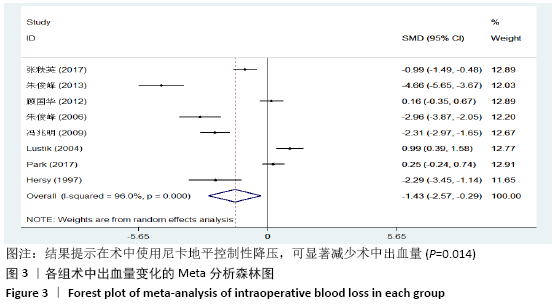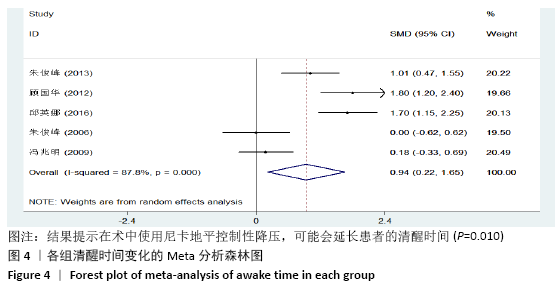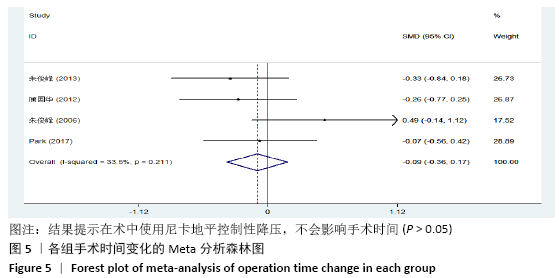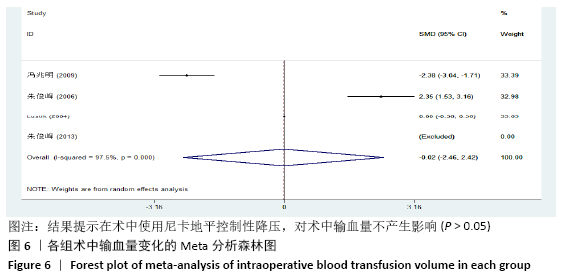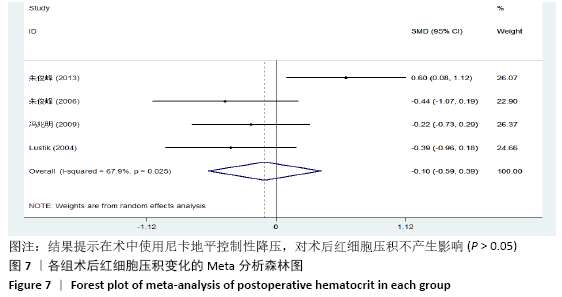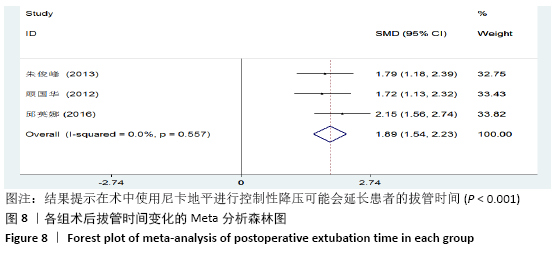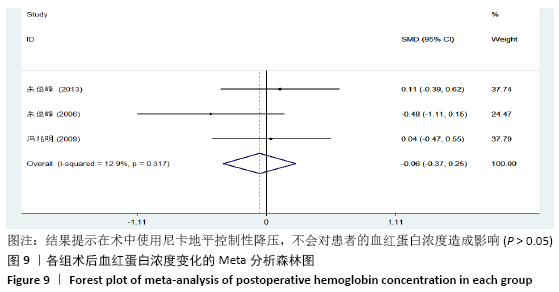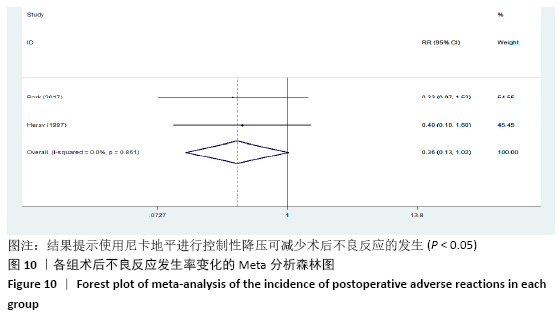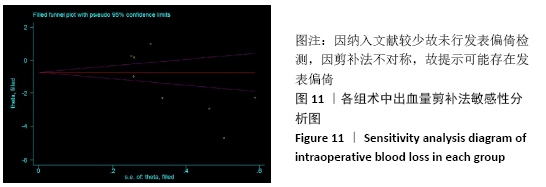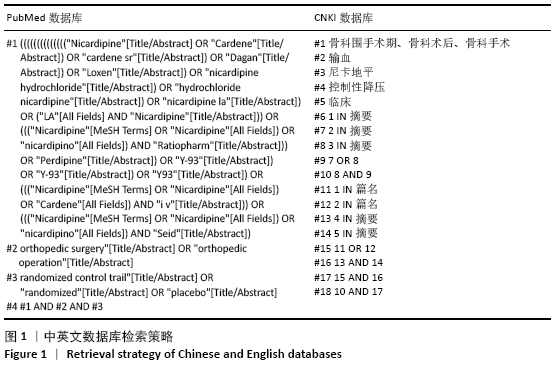[1] SNAVELY JE, SERVICE BC, MILLER D, et al. Needlestick and sharps injuries in orthopedic surgery residents and fellows. Infect Control Hosp Epidemiol. 2019;40(11):1253-1257.
[2] WALKER R, MORRISON Z, CAMPBELL M. Trends in orthopedic surgery reimbursement from 2000 to 2015. Orthopedics. 2020; 43(3):187-190.
[3] SHARQZAD AS, CAVALHEIRO C, ZAHAR A, et al. Blood loss and allogeneic transfusion for surgical treatment of periprosthetic joint infection: a comparison of one- vs. two-stage exchange total hip arthroplasty. Int Orthop. 2019;43(9):2025-2030.
[4] ALLISON TA, BOWMAN S, GULBIS B, et al. Comparison of Clevidipine and Nicardipine for Acute Blood Pressure Reduction in Patients With Stroke. J Intensive Care Med. 2019;34(11-12):990-995.
[5] HAFEEZ S, GRANDHI R. Systematic Review of Intrathecal Nicardipine for the Treatment of Cerebral Vasospasm in Aneurysmal Subarachnoid Hemorrhage. Neurocrit Care. 2019;31(2):399-405.
[6] 周宗科,翁习生,孙天胜,等.中国骨科手术加速康复—围术期血液管理专家共识[J].中华骨与关节外科杂志,2017, 10(1):1-7.
[7] CIOFU O, SMITH S, LYKKESFELDT J. A systematic Cochrane Review of antioxidant supplementation lung disease for cystic fibrosis. Paediatr Respir Rev. 2020;33:28-29.
[8] JADAD AR, MOORE RA, CARROLL D, et al. Assessing the quality of reports of randomized clinical trials: is blinding necessary? Control Clin Trials. 1996;17(1): 1-12.
[9] 张轶英,田奔,巩孝文,等.右美托咪定联合尼卡地平用于老年骨科手术患者控制性降压时对炎症因子的影响[J].现代生物医学进展,2017,17(17):3370-3373.
[10] PARK C, KIM JY, KIM C, et al. Nicardipine effects on renal function during spine surgery. Clin Spine Surg. 2017;30(7): E954-E958.
[11] 邱英娜,隋国龙,高斌.右美托咪定复合尼卡地平对老年骨科手术患者控制性降压的干预研究[J].国际医药卫生导报, 2016,22(8):1133-1135.
[12] 朱俊峰,冯兆明.右美托咪定联合尼卡地平用于骨科手术的控制性降压[J].中华生物医学工程杂志,2013,19(4):317-320.
[13] 顾国华,朱俊峰.右美托咪定复合尼卡地平用于骨科手术患者控制性降压的效果[J]. 中华麻醉学杂志,2012,32(11): 1357-1359.
[14] 朱俊峰,冯兆明.尼卡地平复合拉贝洛尔控制性降压的临床研究[J].陕西医学杂志,2009,38(12):1610-1611.
[15] 朱俊峰.尼卡地平控制性降压用于骨科手术20例[J].中国煤炭工业医学杂志, 2006,9(2):110-111.
[16] LUSTIK SJ, PAPADAKOS PJ, JACKMAN KV, et al. Nicardipine versus nitroprusside for deliberate hypotension during idiopathic scoliosis repair. J Clin Anesth. 2004;16(1):25-33.
[17] HERSEY SL, O’DELL NE, LOWE S, et al. Nicardipine versus nitroprusside for controlled hypotension during spinal surgery in adolescents. Anesth Analg. 1997; 84(6):1239-1244.
[18] OANA C, SHERIE S, JENS L. A systematic Cochrane Review of antioxidant supplementation lung disease for cystic fibrosis. Paediatr Respir Rev. 2020;33:28-29.
[19] GREENSTEIN AS, GORCZYCA JT. Orthopedic Surgery and the Geriatric Patient. Clin Geriatr Med. 2019;35(1):65-92.
[20] GOODMAN SM, SPRINGER B, GUYATT G, et al. 2017 American College of Rheumatology/American Association of Hip and Knee Surgeons Guideline for the Perioperative Management of Antirheumatic Medication in Patients With Rheumatic Diseases Undergoing Elective Total Hip or Total Knee Arthroplasty. Arthritis Rheumatol. 2017;69(8):1538-1551.
[21] PAWASKAR A, SALUNKE AA, KEKATPURE A, et al. Do autologous blood transfusion systems reduce allogeneic blood transfusion in total knee arthroplasty? Knee Surg Sports Traumatol Arthrosc. 2017;25(9):2957-2966.
[22] MORENO DH, CACIONE DG, BAPTISTA-SILVA JC. Controlled hypotension versus normotensive resuscitation strategy for people with ruptured abdominal aortic aneurysm. Cochrane Database Syst Rev. 2018;6(6):D11664.
[23] McKeever RG, Hamilton RJ. Calcium Channel Blockers. 2020. In: StatPearls [Internet]. Treasure Island (FL): StatPearls Publishing. 2020. Doi:10.1007/BF02125750.
[24] ALSHAMI A, ROMERO C, AVILA A, et al. Management of hypertensive crises in the elderly. J Geriatr Cardiol. 2018;15(7): 504-512.
[25] MALESKER MA, HILLEMAN DE. Intravenous labetalol compared with intravenous nicardipine in the management of hypertension in critically ill patients. J Crit Care. 2012;27(5):527-528.
[26] MASTROPIETRO CW, ARANGO UD. Nicardipine for hypertension following aortic coarctectomy or superior cavopulmonary anastomosis. World J Pediatr Congenit Heart Surg. 2016;7(1):32-35.
[27] KIM JY, SONG SH, CHO JH, et al. Comparison of clinical efficacy among remifentanil, nicardipine, and remifentanil plus nicardipine continuous infusion for hypotensive anesthesia during arthroscopic shoulder surgery. J Orthop Surg (Hong Kong). 2017;25(2):2309499017716251.
[28] MITRA S, CARLYLE D, KODUMUDI G, et al. New advances in acute postoperative pain management. Curr Pain Headache Rep. 2018;22(5):35.
[29] BACH AM, FORMAN A, SEIBAEK L. Postoperative pain management: a bedside perspective. Pain Manag Nurs. 2018;19(6):608-618.
[30] STONE M L, KELLY J, MISTRY M, et al. Use of nicardipine after cardiac operations is safe in children regardless of age. Ann Thorac Surg. 2018;105(1):181-185.
[31] MENG F, CHANG Z, AN S, et al. Application of controlled hypotension in cesarean section of pregnant women with high-risk hemorrhage. Pak J Pharm Sci. 2018; 31(6(Special)):2885-2889.
[32] DONG J, MIN S, HE KH, et al. Effects of the nontourniquet combined with controlled hypotension technique on pain and long-term prognosis in elderly patients after total knee arthroplasty: a randomized controlled study. J Anesth. 2019;33(5):587-593.
[33] CHOUDHARY P, DUTTA A, SETHI N, et al. Pre-induction fentanyl dose-finding study for controlled hypotension during functional endoscopic sinus surgery. Indian J Anaesth. 2019;63(8):653-659.
[34] WON YJ, LIM BG, YEO GE, et al. The effect of nicardipine on the surgical pleth index during thyroidectomy under general anesthesia: a prospective double-blind randomized controlled trial. Medicine (Baltimore). 2017;96(6):e6154.
[35] ROSENFELDT Z, CONKLEN K, JONES B, et al. Comparison of Nicardipine with Clevidipine in the Management of Hypertension in Acute Cerebrovascular Diseases. J Stroke Cerebrovasc Dis. 2018;27(8):2067-2073.
[36] SADEGHI M, SABER H, SINGH A, et al. Nicardipine associated risk of short-term mortality in critically ill patients with ischemic stroke. J Stroke Cerebrovasc Dis. 2019,28(5):1168-1172.
[37] KAMO H, UENO Y, SUGIYAMA M, et al. Pontine hemorrhage accompanied by neuromyelitis optica spectrum disorder. J Neuroimmunol. 2019;330:19-22.
[38] 朴惠明.右美托咪定联合尼卡地平用于正颌手术控制性降压的临床效果评价[J]. 吉林医学,2020,41(5):1160-1161. |
